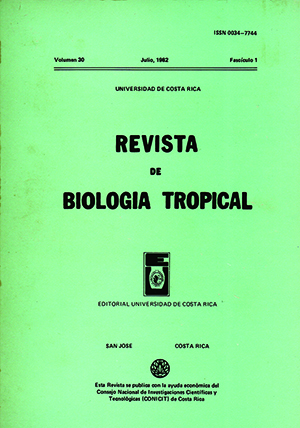Abstract
Allelopathic substances were found in vegetative and reproductive structures of Gliricidia sepium, a tropical legume widely used for shade in pastures and plantations of perennial crops. Aqueous extracts inhibited seed germination in Bidens pilosa, a weed and Lycopersicon esculentum, tomato; the effect was stronger when the plant parts were macerated. The allelopathic effect did not decrease during the dry season when these decidous trees are phenologically active. The highest concentration of allelopathic substances was observed in the leaves and in the bark of the roots. An extract of Gliricidia leaves also inhibited germination of its own seeds. A phenolic substance, presumably protocatechic acid was tentatively identified from aqueous leaf extracts by means of paper chromatography. The presence of these allelopathic substances would suggest caution in using Gliricidia sepium as shade trees for perennial crops, while their extracts could be used as fungicides or wood preservatives.References
Anaya, A.L. & A. Gómez-Pompa. 1971. Inhibición del crecimiento productivo por el "Piru" (Schinus molle L.) Rev. Soc. Mexicana Hist. Nat., NO. 32: 99-109.
Bazzaz, F.A. 1975. Plant species diversity in old-field successional ecosystems in Southern Illinois. Ecology, 56: 485-488.
Carley, H.E. & R.D. Watson. 1968. Effect of various aqueous plant extracts on seed germination. Bot. Gaz. 129: 57-62.
Coutinho, L.M. & F. Hashimoto. 1971. Sobre o efeito inibitório da germinacao de sementes produzido por folhas de Calea cuneifolia D.C. Ciencia e Cultura, 23: 759-764.
Daccarett, M. & J. Blydenstein. 1968. La influencia de los árboles leguminosos y no leguminosos sobre el forraje que crece bajo ellos. Turrialba, 18: 405-409.
Del Moral, R. & R.G. Gates. 1971. Allelopathic potential of the dominant vegetation of Western Washington. Ecology, 52: 1031-1037.
Del Moral, R. & C. H. Muller. 1970. The allelopathic effects of Eucalyptus camaldulensis. Amer. Midl. Nat. 83: 254-282.
Fisher, R.F. 1980. Allelopathy: a potential cause of regeneration failure. J. For., 78: 346-348.
Ibrahim, R.K. & G.H.N. Towers. 1959. Conversion of salieylic acid to genfisic acid and o-pyroca techic acid , all labeled with carbon-14 , in plants, Nature, 184: 1803.
Jurd, L. 1976. A phenolic isoflav-3 -ene from Gliric idia sepium. Tetrahedron Letters, NO. 21: 1741-1744.
Lines, Nuria & L.A. Fournier. 1979. Efecto alelopático de Cupressus lusitanica Mili., sobre la germinación de semillas de algunas hierbas. Rev. Biol. Trop., 27: 223-229.
Lodhi, M.A.K. 1976. Role of allelopathy as expressed by dominating trees in a lowland forest in controlling the productivity pattern of herbaceous growth. Amer. J. Bot., 63: 1-8. 1976.
Lodhi, M.A.K. 1978. Allelopathic effects on decaying litter of dominant trees and their associated soil in a lowland forest community. Amer. J. Bot., 65: 340-344.
Maía, R .H. & E. Jiménez. 1966. Importancia de las sustancias polifenólicas en el mecanismo fisiológico de la resistencia del cacao (Theobroma cacao L.) a Phythophthora palmivora Butl. Turrialba , 16: 319-329.
Manners, G.D . & L Jurd. 1979. Additional flavonoids in Gliricidia sepium. Phytochem, 18: 1037-1042.
Putnam, A.R. & W.B. Duke. 1974. Biological supression of weeds: evidence for allelopathy in accessions of cucumber. Science, 185: 370-371.
Rice, E.L. 1972. A1lelopathic effects of Andropogon virginicus and its persistence in old fields. Ecology, 56: 35-49.
Rice, E.L. 1979. Allelopathy an update. Bot. Rev., 45: 15-109.
Sullivan, J.D. Jr., & M. Ikawa. 1972. Variations in inlubition of growth of five Chlorella strains by mycotoxine and other toxic substances, J. Agr. Food Chem., 20; 921-922.
Whittaker, R. H. & P.P. Feeny. 1971. Allelochemic; chemical interaction between species. Science, 171: 757-770.
##plugins.facebook.comentarios##

This work is licensed under a Creative Commons Attribution 4.0 International License.
Copyright (c) 1982 Revista de Biología Tropical


